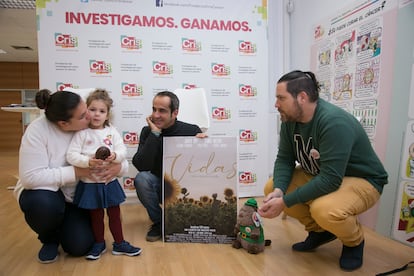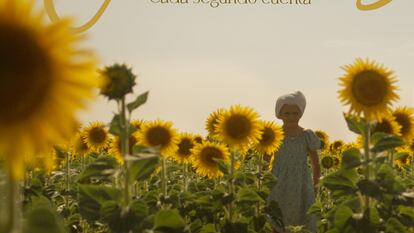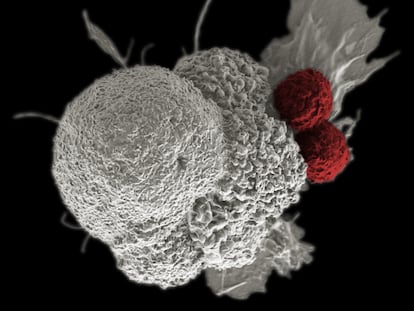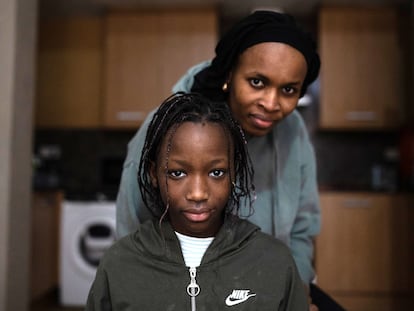Daniela and Antonio’s story: The girl with an inoperable tumor and the doctor who would not give up
The CRIS Foundation has released a short film about the career of a pediatrician who sought a cure for a baby who had very little chance of surviving her disease


Daniela is three years old. She is a cheerful and lively little girl who loves to dance and sing. At first glance, it is hard to believe the difficult road she and her family have traveled since she came into the world. She was born with a 10-centimeter tumor, called a congenital fibrosarcoma. Normally, it can be cured with surgery, but in her case, the tumor was inoperable because of its location on an aneurysm she had in her abdominal aorta. Nor could the tumor be treated with chemotherapy or radiation, her doctor says, because she would not have been able to survive the process. But her pediatrician, Antonio Pérez, found a treatment that cured the girl in a few months. Three years later, four more children have benefited from the same procedure.
The little girl runs around with a stuffed animal and asks her parents to play as they tell their story to EL PAÍS. They say they never lost hope. Silvia de Marcos, her mother, recalls that, despite being told that her chance of survival was 1%, they always remained optimistic. “You can hit the lottery with those odds. We always thought Daniela would be in that 1% and [now] she is,” de Marcos says, as she looks at her daughter.
Their optimism was such that they would not allow visiting family and friends to cry in Daniela’s presence. “We didn’t let anyone cry in front of her. If you cry and show that you are [upset], you end up transmitting it to them,” Daniela’s mother explains.
Antonio Pérez is the director of pediatric oncology at Madrid’s La Paz University Hospital. He also heads the Advanced Therapy Research Unit of the CRIS (Cancer Research Innovation in Science) Cancer Foundation at the same hospital. This foundation is the standard in researching cures for tumors, and it has research units for both childhood and adult cancers in several hospitals in Spain. The pediatrician notes that CRIS invests almost €1 million a year in researching these diseases in children. Last November, the foundation released Vidas: Cada segundo cuenta [Lives: Every Second Counts], a short film that tells the story of Daniela and her pediatrician and aims to raise awareness about the importance of research in the battle against cancer.
De Marcos was 37 weeks pregnant when she was told that something was wrong with Daniela. However, neither she nor her husband, Miguel Ángel González, anticipated how serious the situation would be. The mother explains that her idea all along was that she would give birth, go home with the baby and return to the hospital for routine check-ups, but they were unable to do that: “In the delivery room, they told us that they were taking the baby to the ICU and that they didn’t know if she would survive.” They spent a month and a half in the hospital before they could go home.
During that time, Daniela underwent countless tests until doctors found the right treatment. “We knew she was going to be born with this problem, but we couldn’t know exactly what it was until she was diagnosed after her birth,” the pediatrician says. Pérez describes the seriousness of the situation: “The tumor kept growing and the girl could have died at any moment.”
Pérez found the solution in a 40-year-old study that mentioned the driver gene, a mutation that affects the genome and accelerates the growth of cancer cells. That connection was one of the aspects of Daniela’s case that was most striking to Nacho Ros, the director of the short film. He was surprised to learn “how something that happened by chance saved a girl’s life 40 years later.”

The pediatrician explains that this genetic alteration is responsible for the tumor. The drug he used on Daniela is designed to attack the mutation directly and has practically no side effects. “It causes the tumor to ‘melt,’ and in about three months it disappears,” the researcher adds. Daniela began the treatment on October 9, 2019. For a month and a half, she took 2 milliliters of medication at 9 am and at 9 pm, every day like clockwork. Five months later, the tumor had disappeared without a trace.
In addition to the fibrosarcoma, Daniela was diagnosed with an abdominal aortic aneurysm and thrombosis in her left iliac vein, so she has circulation problems in her lower extremities. De Marcos is not sure that the girl is aware of the seriousness of her situation, but she does know that Daniela is different. After the aneurysm surgery, she was left with a vertical scar on her abdomen; she shows it to others unselfconsciously. “She tells people that she has it because she is a superhero and [that’s why] others don’t [have the scar],” De Marcos says tenderly.
Pérez emphasizes the importance of this type of progress in curing cancer. This fibrosarcoma usually appears during the first year of life, although approximately half of the children who have it are born with it or develop it during the first month after birth. It manifests as a lump in the legs, fingers or neck, and it is removed by surgery, which amputates the affected part. However, when the tumors appear in more complicated areas and cannot be operated on, as in Daniela’s case, the prognosis is bleak.
The drug Daniela took was in the clinical trials stage and therefore unavailable, so Pérez and his team had to apply for a compassionate-use exception, a special authorization from the Spanish Agency of Medicines and Health Products. Since then, Pérez has resorted to this method a further four times to care for children who have the same condition, since the treatment is not yet approved. “We have cured five cases without surgery; I will ask for it again a sixth time [if necessary],” he says.
Daniela’s case is exceptional. In Spain, childhood cancer represents 1% of the total number of tumors diagnosed. Compared with neonatal cancer, there is one case for every 10,000 adults. Pérez says that most childhood tumors occur in children between the ages of three and eight: “There aren’t more than eight or 10 [cases] a year” in children under one month old.
Both Ros and Pérez have been working with CRIS since the foundation’s beginnings. Ros also volunteers at the hospital. When the director learned about Daniela’s case, he knew that her story “had to be told.” But he also sought to go beyond that. He wanted to convey the message that cancer doesn’t stop with the happy ending to Daniela and Antonio’s story. “We have to raise awareness that, for cancer, research is key,” says Ros.
Foundations such as CRIS play a key role in researching cures for the disease as well as in the lives of the families of sick children. “You don’t find them, they show up in your life,” says De Marcos. Now, Daniela’s family actively collaborates with the foundation because they want to give back and make sure that more children receive the help Daniela did. It is clear to them that the only way to save the kids after Daniela is to make her story visible. “I have to do it for other children,” says De Marcos.
Sign up for our weekly newsletter to get more English-language news coverage from EL PAÍS USA Edition
Tu suscripción se está usando en otro dispositivo
¿Quieres añadir otro usuario a tu suscripción?
Si continúas leyendo en este dispositivo, no se podrá leer en el otro.
FlechaTu suscripción se está usando en otro dispositivo y solo puedes acceder a EL PAÍS desde un dispositivo a la vez.
Si quieres compartir tu cuenta, cambia tu suscripción a la modalidad Premium, así podrás añadir otro usuario. Cada uno accederá con su propia cuenta de email, lo que os permitirá personalizar vuestra experiencia en EL PAÍS.
¿Tienes una suscripción de empresa? Accede aquí para contratar más cuentas.
En el caso de no saber quién está usando tu cuenta, te recomendamos cambiar tu contraseña aquí.
Si decides continuar compartiendo tu cuenta, este mensaje se mostrará en tu dispositivo y en el de la otra persona que está usando tu cuenta de forma indefinida, afectando a tu experiencia de lectura. Puedes consultar aquí los términos y condiciones de la suscripción digital.
More information
Últimas noticias
Most viewed
- Oona Chaplin: ‘I told James Cameron that I was living in a treehouse and starting a permaculture project with a friend’
- Sinaloa Cartel war is taking its toll on Los Chapitos
- Reinhard Genzel, Nobel laureate in physics: ‘One-minute videos will never give you the truth’
- Why the price of coffee has skyrocketed: from Brazilian plantations to specialty coffee houses
- Silver prices are going crazy: This is what’s fueling the rally











































